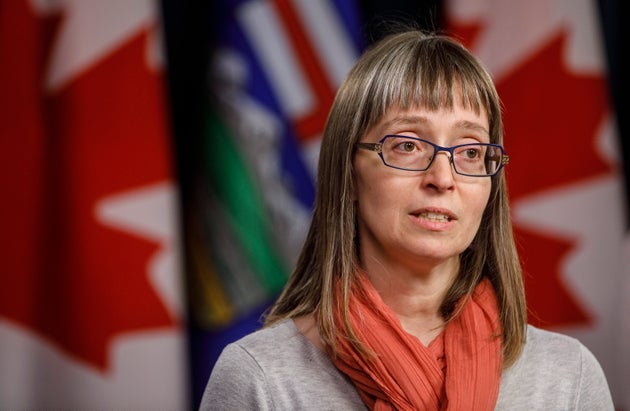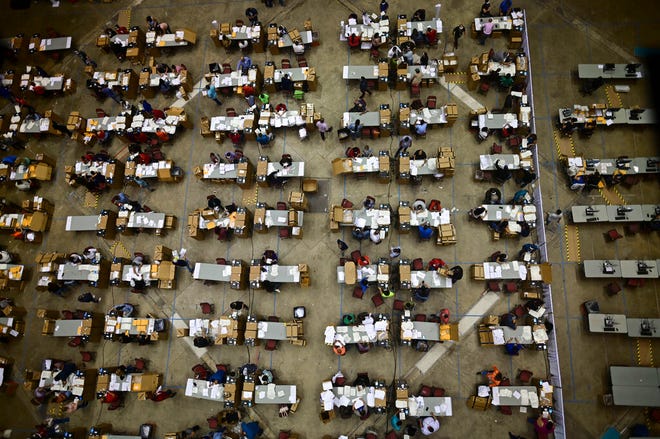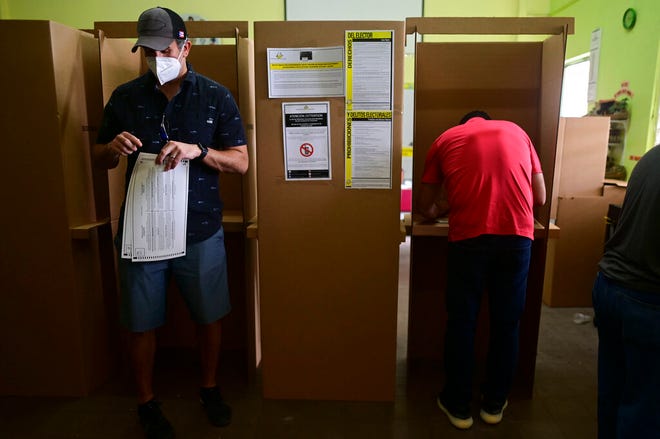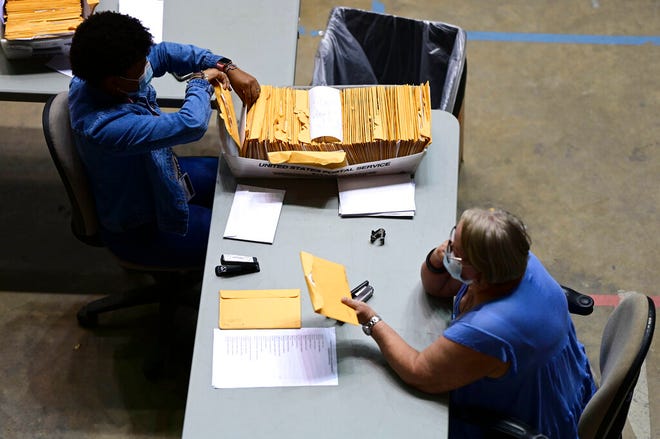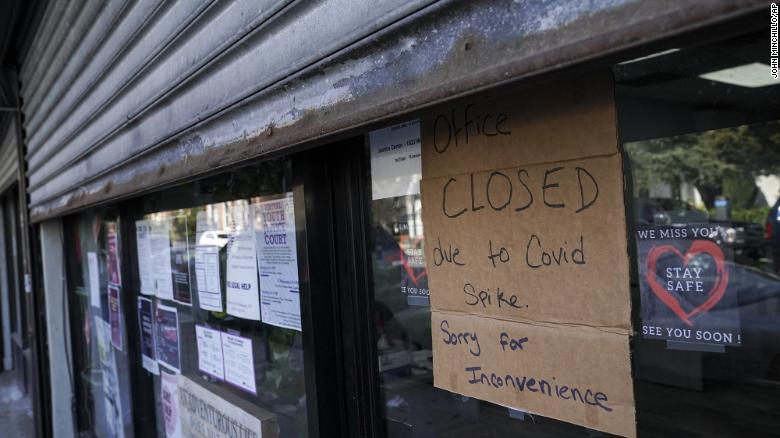Robson Fletcher CBC

© CBC Alberta Premier Jason Kenney, left, in an April televised address about the COVID-19 situation in the province. At right, Kenney responds to a question about the spread of the virus, at an unrelated press conference in October

© CBC
In Alberta, the novelty of the novel coronavirus has worn off.
Back in the spring, the threat was new and unknown. Provincial leaders acted accordingly, with an abundance of caution. Seeing what was likely coming, they cancelled in-person classes across Alberta with just 56 reported cases of the disease.
By late March, with the province recording 56 new cases per day, non-essential businesses were forced to close and gatherings were restricted to a maximum of 15 people, including in churches and private homes. At the same time, Premier Jason Kenney gave police new powers to enforce public-health orders.
In April, the premier convened a special, televised address. He laid out the scale of the threat in somber tones and, saying he didn't want to sugar-coat the situation, shared several models of the disease's potential spread. The worst-case scenario, he said, could see as many as 6,600 deaths by the end of the summer. That is, if Albertans didn't act.
But Albertans did act. Collective efforts were successful in the curbing the spread of the virus. Apart from two major outbreaks at meat-packing plants, COVID-19 was largely contained elsewhere in the province. By June, just a couple dozen new cases were being reported each day. A week or more would pass with zero deaths.
Everyone breathed a collective sigh of relief. Dr. Deena Hinshaw, the province's chief medical officer of health, dialled back her daily addresses from five days a week, to three, to two. The province's data crunchers stopped publishing updated statistics on weekends and holidays. Summer arrived, and the living seemed easier.
How things have since changed.
Setting new highs
On Tuesday, Alberta Health announced 2,268 new cases and 15 more deaths since Friday, bringing the total deaths to 338. (The four-day data dump was the result of the aforementioned end to weekend reporting, coupled with some computer maintenance on Monday.)
New records were set — again — for hospitalizations, ICU admissions and active cases.
And yet, the response from provincial leaders has remained relatively subdued, at least compared with those early days. At a press conference on an unrelated matter on Monday, Kenney was asked about the situation and said Albertans can expect additional measures later this week, but offered no specifics.
He spoke seriously of the situation, urging young Albertans, in particular, to "knock it off" with the partying and social gatherings. His words carried less urgency, though, compared with his April address.
"I know people are tired of it," the premier said. "We're all fed up with this."
While many Albertans may be tired of the public-health restrictions — and, perhaps, inured to the threat of the virus — many others fear the worst is yet to come. Various polls have shown the divide often tends to fall along partisan lines.
Predicting the future is impossible, of course, but a close look at Alberta's present situation reveals a few things: the current wave of COVID-19 is larger, more widespread and more politicized than the first.
Bigger
Whether you call it a wave, a surge, or a simple increase in spread, recent data from Alberta Health makes it clear the province is recording more cases of COVID-19 than ever.
In early October, around 150 cases per day were being detected by the provincial lab. By mid-October, it was into the 300s. And by the end of the month, daily cases peaked above 600 for the first time in the province's history.
That marks a doubling time of about 2½ weeks.
If current trends continue, physicians and researchers worry we could be soon be seeing thousands of cases per day in Alberta.
Adjusted for population, Alberta now has the second-highest number of active COVID-19 cases of all provinces. (The highest is Manitoba, where a "code red" situation was declared in Winnipeg this week, bringing widespread closures and restrictions to the city.)
There is a focus on cases because they are a leading indicator of the disease. Where cases go, severe outcomes tend to follow. And Alberta has been seeing a surge in those, as well.
Last week, the number of patients in hospital with COVID-19 hit an all-time high. The province also set a record for the number of patients in intensive care.
Many of these people caught the disease while in hospital for other reasons, but this still has an effect on the capacity of the health-care system. In Edmonton, physicians warned the system is at a "tipping point," after outbreaks at four hospitals.
Calgary's hospitals have seen outbreaks, too. And while they may currently be under less strain than those in Edmonton, they are still stretched.
For the first time, the Peter Lougheed Centre has activated the field hospital it built in the spring. The temporary structure in the hospital's parking lot sat empty for months after construction because there was no need for the extra space.
Now, it's being used 20 hours per day as an auxiliary emergency department, to make more room for COVID-19 patients in the hospital, proper.
Deaths, too, have been rising.
After a lull in the summer, the number of people dying from COVID-19 has been creeping back up, especially lately.
Over the past week, the province has recorded more than four deaths per day, on average, for the first time since late April.
There is typically a delay of up to several days in reporting deaths, as well, so the most recent numbers are usually an undercount.
But it's not just the height of the current wave that's different from the spring surge. It's also the breadth.
Wider
Alberta saw a huge spike in COVID-19 cases in April, but these were largely localized events — primarily related to major outbreaks at two slaughterhouses in the southern part of the province.
First, the Cargill meat-packing plant near High River, just south of Calgary, saw the virus sweep through its staff. By the time it was over, 949 employees had tested positive and two died. A total of 1,560 cases were linked to the plant, including family members and other close contacts.
The next outbreak struck the JBS slaughterhouse in Brooks. By early May, 487 workers at that facility had come down with COVID-19.
At the same time, the virus spread through the community, which is home to about 15,000 people. At the height of the spread, Brooks had 26 per cent of Alberta's total active cases, despite making up just 0.3 per cent of the province's population.
The situation is different now. Significant numbers of COVID-19 are being reported in all corners of Alberta, making containment more of a challenge.
The virus's heaviest incursion has been in the major cities. Edmonton and Calgary have the most active cases, and the municipal governments have taken their own counter-measures, including mandatory masks in public places.
But smaller centres haven't been spared. Active cases in Lethbridge shot up six-fold in the span of three weeks in October, giving it the highest rate per capita among the larger cities in the province. There have also been smaller outbreaks in more rural areas.
Together, this has created a new situation for Alberta, with significant numbers of new and active cases in all five health zones simultaneously.
Back in the spring, Alberta Health partnered with the slaughterhouse operators and deployed on-site testing and specific counter-measures to curb the spread of the disease. Now it's waging a war on many more fronts.
At the same time, Albertans are more divided about how to best fight the battle.
Politics
The pandemic's arrival in the spring brought levels of cross-partisan co-operation not witnessed in a long time.
Canadians marvelled as Ontario Premier Doug Ford and Prime Minister Justin Trudeau, once bitter political foes, made a habit of complimenting one another.
Even Kenney, who has been perhaps the most antagonistic premier toward the federal government, got in on the love.
It didn't last.
The Alberta government's anti-Trudeau rhetoric has since returned. It's even been directed toward the pandemic response, in particular.
Unlike most provinces, Alberta has so far refused to adopt the national COVID-19 tracing app, steadfastly standing by its own ABTraceTogether app, which has been plagued by functionality problems on iPhones.
In response to questions from the opposition last week, government MLAs mocked the federal alternative with heckles of "Trudeau's app," echoing the language of federal Conservative MP Michelle Rempel's criticism of the software.
The provincial government's own approach to curb the spread of COVID-19, meanwhile, has become the subject of increasing criticism from the opposition.
The Alberta NDP, too, has been putting aside any early-pandemic sense of solidarity. It has launched a series of recent attacks on the government's COVID-19 response, especially with respect to school reopenings.
Both sides have also tried to use Dr. Hinshaw to their advantage. Early on in the pandemic, the chief medical officer of health was seen by many Albertans as a bastion of apolitical, scientific advice. But increasingly politics is seeping into the perception of her role, as much as she may try to resist it.
In late September, the NDP proposed a change to Hinshaw's position. They wanted to make her an independent officer of the legislative assembly, rather than an advisor to cabinet. Such a change would give her more ability to disagree with the government — and more protection from being fired.
But the move put her in an awkward spot. Hinshaw tried to stay neutral, saying she could work "within whatever framework the government chose to set out." The NDP and UCP each tried to spin that as supporting their position. Ultimately, the motion to change her role was defeated at committee.
Hinshaw faces similar awkwardness in her regular press briefings when asked pointed questions about how the government's recent reluctance to introduce new public-health restrictions, at least relative to its approach in the spring, squares with the record-high number of cases and hospitalizations.
In response, Hinshaw has repeatedly explained that Alberta's COVID-19 countermeasures need to be considered as a whole, including both the benefits they may bring in terms of curbing disease spread and the harms they may inflict on the economy and Albertans' physical and mental health.
This is entirely consistent, logically, with the government's position, but many observers continue to look for any crack of daylight between what UCP ministers and MLAs say versus what the chief medical officer of health is saying — even in tone, if not content.
On Tuesday, Opposition Leader Rachel Notley took the unusual step of scheduling her own press conference after Hinshaw's scheduled address. This kind of manoeuvre typically happens in response to a politically charged government announcement, not a public health update.
All told, this has changed the terrain of the battlefield. Public health officials are now having to navigate new political realities while also trying to tame the spread of an autumn wave that has risen higher and spread wider than the one in the spring.
And winter is on its way.
In Alberta, the novelty of the novel coronavirus has worn off.
Back in the spring, the threat was new and unknown. Provincial leaders acted accordingly, with an abundance of caution. Seeing what was likely coming, they cancelled in-person classes across Alberta with just 56 reported cases of the disease.
By late March, with the province recording 56 new cases per day, non-essential businesses were forced to close and gatherings were restricted to a maximum of 15 people, including in churches and private homes. At the same time, Premier Jason Kenney gave police new powers to enforce public-health orders.
In April, the premier convened a special, televised address. He laid out the scale of the threat in somber tones and, saying he didn't want to sugar-coat the situation, shared several models of the disease's potential spread. The worst-case scenario, he said, could see as many as 6,600 deaths by the end of the summer. That is, if Albertans didn't act.
But Albertans did act. Collective efforts were successful in the curbing the spread of the virus. Apart from two major outbreaks at meat-packing plants, COVID-19 was largely contained elsewhere in the province. By June, just a couple dozen new cases were being reported each day. A week or more would pass with zero deaths.
Everyone breathed a collective sigh of relief. Dr. Deena Hinshaw, the province's chief medical officer of health, dialled back her daily addresses from five days a week, to three, to two. The province's data crunchers stopped publishing updated statistics on weekends and holidays. Summer arrived, and the living seemed easier.
How things have since changed.
Setting new highs
On Tuesday, Alberta Health announced 2,268 new cases and 15 more deaths since Friday, bringing the total deaths to 338. (The four-day data dump was the result of the aforementioned end to weekend reporting, coupled with some computer maintenance on Monday.)
New records were set — again — for hospitalizations, ICU admissions and active cases.
And yet, the response from provincial leaders has remained relatively subdued, at least compared with those early days. At a press conference on an unrelated matter on Monday, Kenney was asked about the situation and said Albertans can expect additional measures later this week, but offered no specifics.
He spoke seriously of the situation, urging young Albertans, in particular, to "knock it off" with the partying and social gatherings. His words carried less urgency, though, compared with his April address.
"I know people are tired of it," the premier said. "We're all fed up with this."
While many Albertans may be tired of the public-health restrictions — and, perhaps, inured to the threat of the virus — many others fear the worst is yet to come. Various polls have shown the divide often tends to fall along partisan lines.
Predicting the future is impossible, of course, but a close look at Alberta's present situation reveals a few things: the current wave of COVID-19 is larger, more widespread and more politicized than the first.
Bigger
Whether you call it a wave, a surge, or a simple increase in spread, recent data from Alberta Health makes it clear the province is recording more cases of COVID-19 than ever.
In early October, around 150 cases per day were being detected by the provincial lab. By mid-October, it was into the 300s. And by the end of the month, daily cases peaked above 600 for the first time in the province's history.
That marks a doubling time of about 2½ weeks.
If current trends continue, physicians and researchers worry we could be soon be seeing thousands of cases per day in Alberta.
Adjusted for population, Alberta now has the second-highest number of active COVID-19 cases of all provinces. (The highest is Manitoba, where a "code red" situation was declared in Winnipeg this week, bringing widespread closures and restrictions to the city.)
There is a focus on cases because they are a leading indicator of the disease. Where cases go, severe outcomes tend to follow. And Alberta has been seeing a surge in those, as well.
Last week, the number of patients in hospital with COVID-19 hit an all-time high. The province also set a record for the number of patients in intensive care.
Many of these people caught the disease while in hospital for other reasons, but this still has an effect on the capacity of the health-care system. In Edmonton, physicians warned the system is at a "tipping point," after outbreaks at four hospitals.
Calgary's hospitals have seen outbreaks, too. And while they may currently be under less strain than those in Edmonton, they are still stretched.
For the first time, the Peter Lougheed Centre has activated the field hospital it built in the spring. The temporary structure in the hospital's parking lot sat empty for months after construction because there was no need for the extra space.
Now, it's being used 20 hours per day as an auxiliary emergency department, to make more room for COVID-19 patients in the hospital, proper.
Deaths, too, have been rising.
After a lull in the summer, the number of people dying from COVID-19 has been creeping back up, especially lately.
Over the past week, the province has recorded more than four deaths per day, on average, for the first time since late April.
There is typically a delay of up to several days in reporting deaths, as well, so the most recent numbers are usually an undercount.
But it's not just the height of the current wave that's different from the spring surge. It's also the breadth.
Wider
Alberta saw a huge spike in COVID-19 cases in April, but these were largely localized events — primarily related to major outbreaks at two slaughterhouses in the southern part of the province.
First, the Cargill meat-packing plant near High River, just south of Calgary, saw the virus sweep through its staff. By the time it was over, 949 employees had tested positive and two died. A total of 1,560 cases were linked to the plant, including family members and other close contacts.
The next outbreak struck the JBS slaughterhouse in Brooks. By early May, 487 workers at that facility had come down with COVID-19.
At the same time, the virus spread through the community, which is home to about 15,000 people. At the height of the spread, Brooks had 26 per cent of Alberta's total active cases, despite making up just 0.3 per cent of the province's population.
The situation is different now. Significant numbers of COVID-19 are being reported in all corners of Alberta, making containment more of a challenge.
The virus's heaviest incursion has been in the major cities. Edmonton and Calgary have the most active cases, and the municipal governments have taken their own counter-measures, including mandatory masks in public places.
But smaller centres haven't been spared. Active cases in Lethbridge shot up six-fold in the span of three weeks in October, giving it the highest rate per capita among the larger cities in the province. There have also been smaller outbreaks in more rural areas.
Together, this has created a new situation for Alberta, with significant numbers of new and active cases in all five health zones simultaneously.
Back in the spring, Alberta Health partnered with the slaughterhouse operators and deployed on-site testing and specific counter-measures to curb the spread of the disease. Now it's waging a war on many more fronts.
At the same time, Albertans are more divided about how to best fight the battle.
Politics
The pandemic's arrival in the spring brought levels of cross-partisan co-operation not witnessed in a long time.
Canadians marvelled as Ontario Premier Doug Ford and Prime Minister Justin Trudeau, once bitter political foes, made a habit of complimenting one another.
Even Kenney, who has been perhaps the most antagonistic premier toward the federal government, got in on the love.
It didn't last.
The Alberta government's anti-Trudeau rhetoric has since returned. It's even been directed toward the pandemic response, in particular.
Unlike most provinces, Alberta has so far refused to adopt the national COVID-19 tracing app, steadfastly standing by its own ABTraceTogether app, which has been plagued by functionality problems on iPhones.
In response to questions from the opposition last week, government MLAs mocked the federal alternative with heckles of "Trudeau's app," echoing the language of federal Conservative MP Michelle Rempel's criticism of the software.
The provincial government's own approach to curb the spread of COVID-19, meanwhile, has become the subject of increasing criticism from the opposition.
The Alberta NDP, too, has been putting aside any early-pandemic sense of solidarity. It has launched a series of recent attacks on the government's COVID-19 response, especially with respect to school reopenings.
Both sides have also tried to use Dr. Hinshaw to their advantage. Early on in the pandemic, the chief medical officer of health was seen by many Albertans as a bastion of apolitical, scientific advice. But increasingly politics is seeping into the perception of her role, as much as she may try to resist it.
In late September, the NDP proposed a change to Hinshaw's position. They wanted to make her an independent officer of the legislative assembly, rather than an advisor to cabinet. Such a change would give her more ability to disagree with the government — and more protection from being fired.
But the move put her in an awkward spot. Hinshaw tried to stay neutral, saying she could work "within whatever framework the government chose to set out." The NDP and UCP each tried to spin that as supporting their position. Ultimately, the motion to change her role was defeated at committee.
Hinshaw faces similar awkwardness in her regular press briefings when asked pointed questions about how the government's recent reluctance to introduce new public-health restrictions, at least relative to its approach in the spring, squares with the record-high number of cases and hospitalizations.
In response, Hinshaw has repeatedly explained that Alberta's COVID-19 countermeasures need to be considered as a whole, including both the benefits they may bring in terms of curbing disease spread and the harms they may inflict on the economy and Albertans' physical and mental health.
This is entirely consistent, logically, with the government's position, but many observers continue to look for any crack of daylight between what UCP ministers and MLAs say versus what the chief medical officer of health is saying — even in tone, if not content.
On Tuesday, Opposition Leader Rachel Notley took the unusual step of scheduling her own press conference after Hinshaw's scheduled address. This kind of manoeuvre typically happens in response to a politically charged government announcement, not a public health update.
All told, this has changed the terrain of the battlefield. Public health officials are now having to navigate new political realities while also trying to tame the spread of an autumn wave that has risen higher and spread wider than the one in the spring.
And winter is on its way.
